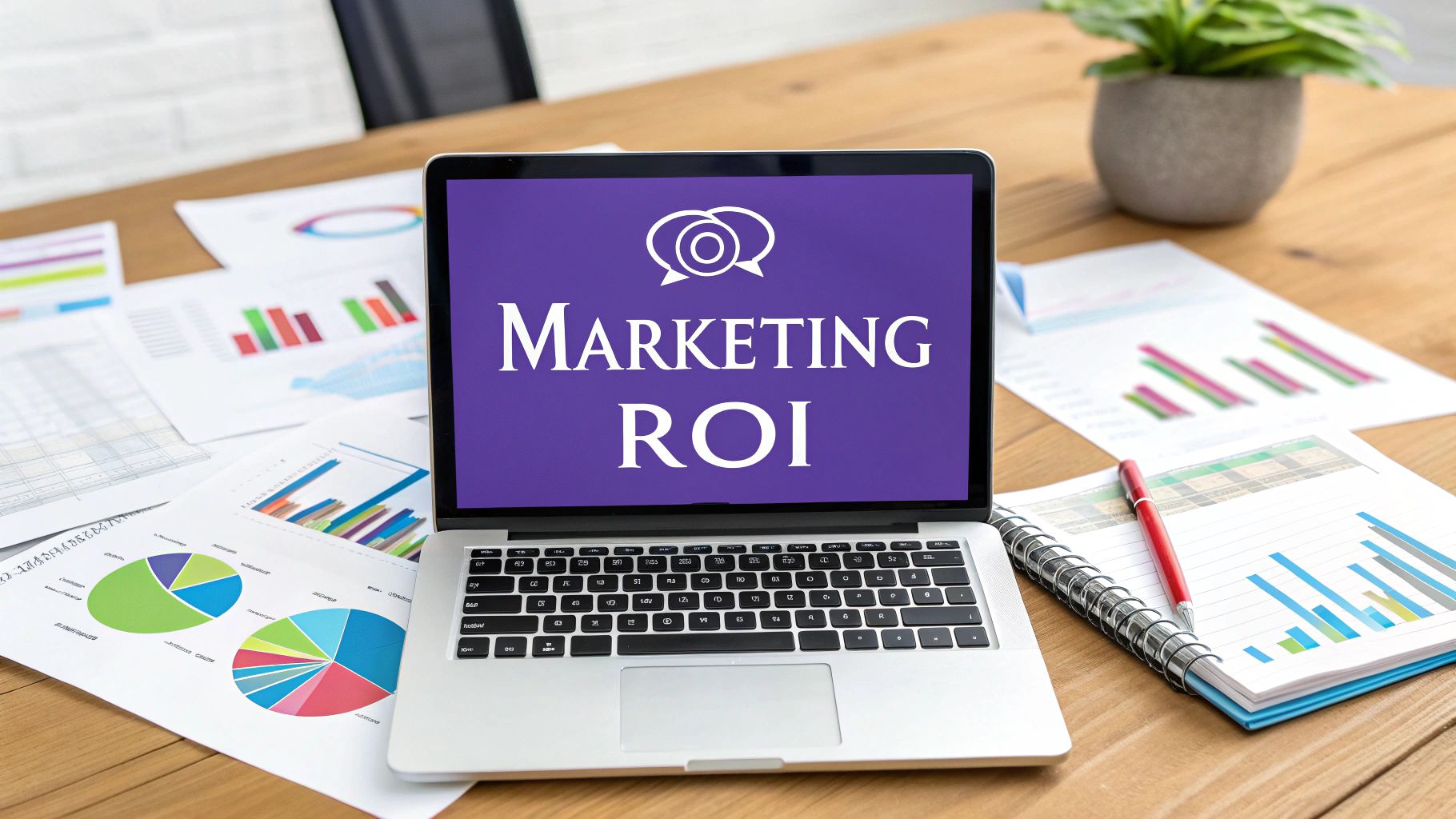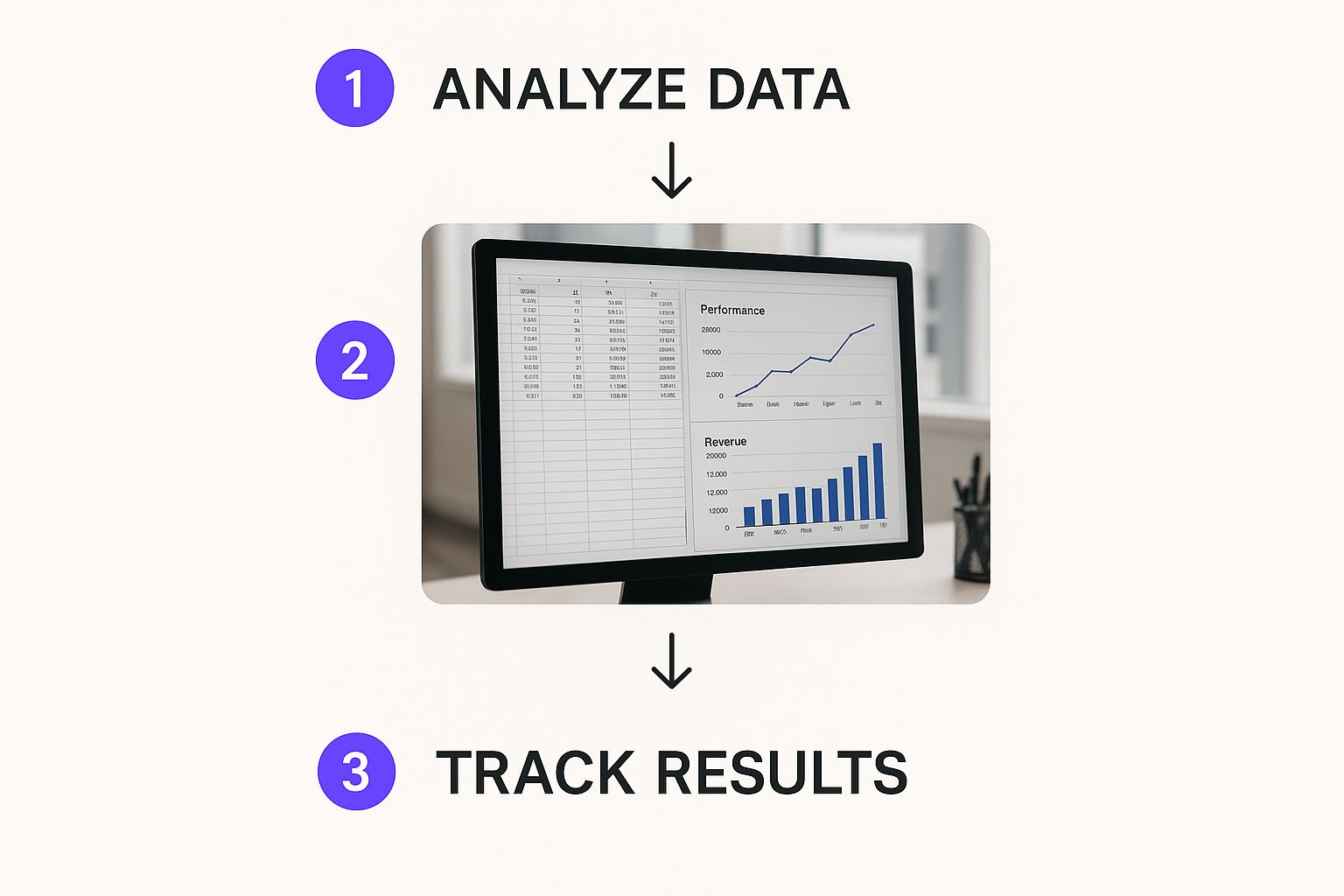Measuring Return on Marketing Investment Made Simple

At its core, measuring your return on marketing investment is pretty simple. You just subtract your total marketing costs from the revenue those campaigns brought in, then divide that number by your marketing costs.
This little formula is powerful. It turns all your marketing activities—the emails, the ads, the social posts—into a clear financial result, showing you exactly how profitable your efforts are. Nailing this is the first step to spending your budget smarter and driving real growth.
Why Measuring Marketing ROI Is No Longer Optional
Let's be real: justifying your marketing budget can feel like an uphill battle. But what if you could flip that conversation completely? This guide is all about turning marketing from what feels like a cost center into a predictable revenue engine. For modern marketers, accurately measuring return on investment isn't just a nice-to-have; it's the non-negotiable skill that gives you the data to drive strategy forward.

This isn't just about defending your budget—it's about confidently asking for more money to pour into the channels that are actually working. When you build a data-driven strategy, you get better resource allocation, more effective campaigns, and a clear path to growing the business. It’s the difference between guessing what works and knowing what drives results.
The Shift From Expense To Investment
The idea of Return on Marketing Investment (ROMI) really started gaining steam back in the 1990s. Businesses were feeling more pressure to justify their spending with tangible profits. Unlike big capital investments, marketing spend is typically an operational expense, which makes measuring its direct return a unique challenge. The term became more common in the early 2000s, helping to formalize how we quantify marketing's impact on the bottom line. This shift in thinking is critical; it reframes marketing as a direct driver of revenue, not just a necessary cost of doing business.
Key Benefits of Consistent ROI Tracking
Getting practical, tracking your ROI consistently delivers some serious advantages that ripple across the entire organization. It’s not about hitting a single number; it's about building a smarter, more agile marketing function.
- Better Decision-Making: When you have clear data, you can confidently shift funds to your top-performing channels and pull back from the ones that aren't pulling their weight.
- More Accountability: With ROI as the main success metric, teams naturally focus on activities that directly impact the bottom line. This creates a culture of performance.
- Easier Budget Justification: Walking into a budget meeting with a clear, positive ROI is the single most powerful way to get approvals and earn executive trust for new ideas.
- Smarter Campaign Optimization: Knowing which campaigns deliver the best returns lets you continuously tweak your messaging, targeting, and creative for maximum impact.
By consistently measuring ROI, you turn marketing from a mysterious art into a predictable science. You gain the power to not only report on past success but also to forecast future growth with greater accuracy.
Getting why marketing ROI is so important is the first step. From here, you can dive into the practical side of things and learn how to measure advertising effectiveness to put these ideas into action. The goal is to create a feedback loop where data from past performance directly sharpens your future strategy. For example, you can take these insights to see what's working on social and learn how to measure social media success, tying those specific metrics back to your overall business goals.
Defining What Success Actually Looks Like
Before you can measure anything, you have to know what you’re aiming for. Measuring your marketing return without clear goals is like driving without a destination—you’ll burn through your budget, but you won't get anywhere meaningful. The first step is to draw a hard line between the metrics that make you feel good and the ones that actually grow the business.
We call the feel-good numbers vanity metrics. These are things like social media likes, page views, or email open rates. They aren't completely useless, but they don't tell you if your marketing is profitable. A post with 10,000 likes that generates zero sales is far less valuable than one with 100 likes that brings in five new customers.
Ditching Vanity for Actionable Metrics
The real story is told by actionable metrics, which are directly tied to revenue and your core business objectives. These are the numbers that show true impact and give you the data you need to make smart strategic decisions. Shifting your focus here is the only way to accurately measure your marketing ROI.
Here are a few of the most important actionable metrics to prioritize:
- Customer Acquisition Cost (CAC): This is the total cost of sales and marketing to land one new customer. Your goal should always be to keep this number as low as possible while still attracting high-value customers.
- Customer Lifetime Value (CLV): This metric predicts the total revenue your business can expect from a single customer over their entire relationship with you. A healthy business model has a CLV that’s significantly higher than its CAC.
- Marketing Qualified Leads (MQLs): These are leads your marketing team has flagged as being more likely to become a customer, based on their engagement and behavior.
- Sales Qualified Leads (SQLs): These are MQLs that have been vetted and passed on to the sales team for a direct follow-up. That MQL-to-SQL conversion rate is a crucial indicator of your lead quality.
- Conversion Rate: The percentage of users or leads who complete a desired action, whether it's making a purchase, filling out a form, or signing up for a trial.
Don't just track numbers—track the right numbers. Focusing on metrics like CAC and CLV provides a clear, financially grounded view of your marketing performance, allowing you to make decisions that directly impact profitability.
Setting SMART Goals for Your Campaigns
Once you know which metrics matter, you need to set clear, campaign-specific goals. The SMART framework is a perfect tool for this, ensuring your objectives are well-defined and actually achievable.
For example, a vague goal like "improve our social media" is useless. A SMART goal, on the other hand, sounds like this: "Increase our MQLs from our LinkedIn campaigns by 20% over the next quarter by promoting our new case study to a targeted audience of project managers."
This goal is:
- Specific: It targets MQLs from a specific channel (LinkedIn) using a specific asset (case study).
- Measurable: The target is a clear 20% increase.
- Achievable: A 20% lift is challenging but realistic for a focused campaign.
- Relevant: Increasing high-quality leads directly supports the business's revenue goals.
- Time-bound: The deadline is "the next quarter," creating a clear timeframe for execution and evaluation.
The type of goal you set will also depend on the campaign's purpose. A brand awareness campaign might focus on metrics like share of voice or branded search volume, while a direct response campaign will be judged on its Cost Per Acquisition (CPA). Defining success for your broader marketing ROI also requires understanding how to measure SEO success and pinpoint the metrics that matter for organic growth. For entrepreneurs, applying these principles is vital, as covered in our guide on social media for entrepreneurs.
The Core Formulas for Calculating Marketing ROI
Feeling intimidated by the math? Don't be. When it comes to figuring out your return on marketing investment, a few core formulas are all you need to unlock a massive amount of insight. You definitely don't need a finance degree.
These calculations are the bedrock for turning raw data into smart, strategic decisions.
Let's kick things off with the most fundamental formula in any marketer's toolkit. It’s simple, direct, and gives you a quick snapshot of how you're doing.
The Classic ROI Formula:(Sales Growth - Marketing Cost) / Marketing Cost
This formula tells you exactly how much revenue you generated for every dollar spent. For instance, say you spent $5,000 on a Google Ads campaign that brought in $25,000 in new sales. Your math would look like this: ($25,000 - $5,000) / $5,000 = 4.
To turn that into a percentage, just multiply by 100. In this case, your ROI is a solid 400%. That means for every $1 you put in, you got $4 back. Not bad at all.
Moving Beyond Revenue to True Profit
While the classic formula is a great starting point, it doesn’t quite tell the whole story. Revenue is fantastic, but profit is what actually keeps the lights on. To get a more accurate picture of your marketing’s financial impact, you need to factor in the cost of what you're selling.
This is where the Cost of Goods Sold (COGS) comes into play. By including COGS, you shift from a revenue-based ROI to one that’s grounded in actual profit.
The Profit-Based ROI Formula:(Sales Growth - COGS - Marketing Cost) / Marketing Cost
Let's jump back to our example. You spent $5,000 on ads and generated $25,000 in sales. But now, let's say the products you sold cost you $10,000 to produce (your COGS). The calculation looks a bit different: ($25,000 - $10,000 - $5,000) / $5,000 = 2.
Your profit-based ROI is now 200%. This number is far more realistic and gives you a much better metric for making smart budget decisions.

Keeping your performance visualized in spreadsheets or dashboards helps you track how these formulas are trending over time, making it easier to spot what’s working and what isn’t.
A Deeper Look at Long-Term Value
For many businesses, especially SaaS companies or anyone with repeat customers, the first sale is just the beginning. If you only focus on immediate ROI, you might undervalue channels that bring in loyal, long-term customers. This is where the Customer Lifetime Value (CLV) to Customer Acquisition Cost (CAC) ratio is an absolute must-know.
- Customer Lifetime Value (CLV): The total profit you can expect to make from a customer over their entire relationship with your brand.
- Customer Acquisition Cost (CAC): The total cost you spend to bring in one new customer.
A healthy business usually aims for a CLV:CAC ratio of at least 3:1. This means a customer's lifetime value is three times what you paid to get them. If your ratio is dipping below that, it could be a sign you're overspending to acquire customers who aren't sticking around.
The real power in measuring marketing return comes from matching the right formula to your business model. An e-commerce store might live and die by profit-based ROI per campaign, while a subscription service is all about that CLV:CAC ratio.
Global data backs this up. A broad analysis found that successful advertising campaigns generated a median profit-based ROI of $2.50 for every $1 spent. This just goes to show how well-executed marketing can be a massive profit driver.
While these core ROI formulas give you a solid framework, specific channels often need their own tailored approach. For instance, if you're working with creators, you'll want to dig deeper. This complete guide on how to measure influencer marketing ROI is a great place to start. Choosing the right formula ensures you’re not just measuring activity, but true business impact.
Common Marketing ROI Formulas and Their Applications
To make things even clearer, here's a quick breakdown of the most common ROI formulas and where they fit best.
| Formula | Calculation | Best Used For |
|---|---|---|
| Basic ROI | (Sales Growth - Marketing Cost) / Marketing Cost |
Quick, high-level performance checks; good for campaigns where COGS is low or not a primary factor. |
| Profit-Based ROI | (Sales Growth - COGS - Marketing Cost) / Marketing Cost |
E-commerce, retail, and any business selling physical products where profit margins are critical for decision-making. |
| CLV:CAC Ratio | Customer Lifetime Value / Customer Acquisition Cost |
SaaS, subscription services, and any business model focused on long-term customer relationships and retention. |
| ROMI (Return on Marketing Investment) | (Gross Profit - Marketing Expenses) / Marketing Expenses |
A more holistic view of marketing's contribution to overall profitability, often used in annual or quarterly reporting. |
Using the right tool for the job is everything. A simple formula might work for a one-off campaign, but understanding the nuances between them is what separates good marketers from great ones.
Untangling the Marketing Attribution Mess
Solid formulas are a great starting point, but they're only as good as the data you feed them. And this is usually where measuring your marketing ROI gets messy. You have to connect a specific marketing action to a specific sale, a process we call marketing attribution.
Imagine this: a customer sees your Instagram ad, clicks a link in your email newsletter a week later, and finally pulls the trigger after Googling your brand. Which channel gets the credit? If you can’t answer that, your ROI calculations are just educated guesses. This is the attribution puzzle, and figuring it out is non-negotiable for accurate measurement.
Picking the Right Attribution Model
An attribution model is just the set of rules you use to give credit to the different touchpoints in a customer's journey. There’s no magic bullet here—the right model depends entirely on your business goals and how long it takes for a customer to buy from you. Pick the wrong one, and you could end up gutting a channel that’s quietly doing all the heavy lifting.
The most common models you'll run into are:
- First-Touch Attribution: This one gives 100% of the credit to the very first interaction a customer has with you. It’s fantastic for figuring out which channels are best at generating initial awareness and filling the top of your funnel. If you're all about lead generation, this model shows you exactly where new prospects are coming from.
- Last-Touch Attribution: The polar opposite. It gives all the credit to the final touchpoint right before a conversion. It's the simplest to set up and is often the default in analytics platforms. The big downside? It completely ignores every single marketing effort that guided the customer to that final click, which can be seriously misleading.
- Linear Attribution: This model is the diplomat, splitting credit equally among every touchpoint. It acknowledges that multiple interactions almost always contribute to a sale, giving you a more balanced view. It's a solid choice for businesses with longer sales cycles where nurturing leads over time is a huge part of the game.
Your attribution model is the lens through which you see your marketing performance. A last-touch model might tell you paid search is your hero, while a first-touch model reveals your blog content is the unsung star that started the entire relationship.
Putting Attribution into Practice
Let's make this real. A SaaS company is trying to get a handle on its marketing performance. A new customer’s journey looked like this: they read a blog post (found via SEO), later attended a webinar (from an email), and finally requested a demo after seeing a LinkedIn ad (Paid Social).
Here’s how different models would slice up the credit:
- First-Touch gives 100% of the credit to the SEO-driven blog post.
- Last-Touch gives 100% of the credit to that final LinkedIn ad.
- Linear would assign 33.3% of the credit to the blog, the webinar, and the ad.
See how the story changes? If the company only looked at last-touch data, they might foolishly decide to slash their content budget, completely missing that the blog is what brought the customer to them in the first place.
Keeping Your Data Squeaky Clean with UTMs
For any of this to work, you need clean, organized data. This is where UTM parameters become your absolute best friend. They're just simple tags you add to the end of your URLs that tell your analytics tools exactly where your traffic is coming from.
A properly tagged URL can track:
- Source: Where the traffic came from (e.g.,
google,linkedin). - Medium: The marketing channel itself (e.g.,
cpc,email,social). - Campaign: The specific campaign you’re running (e.g.,
q4_sale,new_feature_launch).
Using UTMs consistently means you can clearly tell the difference between traffic from a paid LinkedIn ad versus an organic post. This gives you the granular data you desperately need for accurate ROI calculations.
Attribution is a huge hurdle for marketers. In fact, 47% admit they struggle with it across multiple channels. Some channels are easier to track; email marketing, for instance, generates an average of $42 for every dollar spent, while SEO pulls in a strong $22.24 per dollar. But social media remains a tough nut to crack, with half of all marketers citing it as a major measurement headache. You can find more marketing ROI statistics and insights on firework.com.
Properly tracking your social media is a critical piece of this puzzle, and a great place to start is with our comprehensive social media audit checklist. Without a clear view of which channels are actually working, you’re just flying blind.
Turning Your ROI Data Into Smart Decisions
So, you've crunched the numbers, wrestled with attribution, and now you have a spreadsheet brimming with ROI data. What's next? Data just sitting in a dashboard is practically useless. The real magic happens when you turn those numbers into smart, decisive actions that actually grow your business.

This is the moment you connect the dots between your calculations and your strategy. It’s about shifting from just reporting on what happened to proactively shaping what happens next. When you get this right, your marketing moves from being reactive to predictive.
Interpreting Your ROI: What’s a Good Number?
The first question everyone asks is, "What's a good marketing ROI?" The honest-to-goodness answer? It depends. A 5:1 ratio—generating $5 for every $1 spent—is often thrown around as a solid benchmark, but it’s far from a universal rule.
Think about it: a high-margin SaaS company might be thrilled with a 3:1 ROI, while a low-margin e-commerce business might need a 10:1 ratio just to break even. Your "good" number is tied directly to your industry, business model, and overall profit margins.
The goal isn't to hit some arbitrary industry standard. It's to figure out the ROI that fuels sustainable, profitable growth for your business—and then find ways to push it higher.
Comparing ROI Across Different Channels
Your overall ROI is a great health check, but the real, juicy insights come from slicing up your data by channel. Lay out the performance of your paid search, email marketing, social media, and content marketing side-by-side. Your winners and losers will become crystal clear.
You might discover your Google Ads campaigns bring in an immediate 4:1 ROI, which is great. But then you notice your content marketing, while slower to ramp up, delivers a whopping 7:1 ROI over a six-month period. This kind of comparison is absolutely critical. It stops you from making shortsighted decisions, like axing your content budget just because it doesn't offer the instant gratification of paid ads.
True strategic insight doesn't come from a single, blended ROI number. It comes from comparing the performance of individual channels to understand where your marketing dollars are working the hardest.
This is where you spot opportunities. Is your email marketing ROI hitting that impressive 36:1 that some studies say is possible? If it’s not even close, what tweaks can you make? This channel-by-channel view is your roadmap for reallocating your budget with confidence.
A Framework for Actionable Decisions
With a clear picture of channel performance, you can start making some real strategic moves. This isn't about guesswork; it's a systematic approach to getting the most out of every dollar you spend.
- Double Down on Your Winners: Find your top two or three performing channels and feed them more budget. If content marketing is delivering your highest long-term ROI, it’s a no-brainer to invest in more articles, videos, or case studies.
- Optimize or Cut the Losers: For channels with a low or even negative ROI, you have a choice. Can you fix them with better creative, sharper targeting, or a new message? Or is it time to hit pause and move that money to a proven winner?
- Test and Experiment (Smartly): Carve out a small piece of your budget, maybe 10-15%, to experiment with new channels or bold strategies. This lets you explore new growth avenues without taking on a ton of financial risk.
Real-World Scenario: Doubling Down on Content
Let's walk through an example. A B2B tech startup just wrapped up its quarterly ROI review. The data was eye-opening:
- Content Marketing (Blog & SEO): Generated a 6:1 ROI, driving 40% of all new qualified leads over the last six months.
- LinkedIn Ads: Delivered a solid 4:1 ROI with a nice, short sales cycle.
- Display Ads: Produced a disappointing 1.5:1 ROI, with almost no leads converting into actual customers.
Armed with this data, the marketing manager had a clear case to make to the leadership team. She proposed pausing the underperforming display ad campaigns entirely. Just like that, $15,000 was freed up in the quarterly budget.
Her recommendation? Reallocate that entire amount to content marketing. Her justification was simple and backed by hard numbers: while slower, content was their most profitable engine for generating high-quality leads. This is a common and powerful strategy, as we detail in our guide to content marketing for startups, which breaks down how to build a strong foundation for long-term growth.
The leadership team agreed on the spot. The decision wasn't based on a hunch or what competitors were doing; it was a logical, data-backed move to shift resources from a money-losing activity to the company's most profitable marketing channel. This is the ultimate goal of measuring return on marketing investment.
Still Have Questions About Marketing ROI?
Let's tackle some of the most common questions that pop up when you're deep in the trenches, trying to figure out your return on marketing investment. Think of this as your quick-reference guide for navigating those tricky situations and reporting your numbers with confidence.
Even with the slickest formulas and attribution models, you're going to hit a few snags. The real key is understanding the why behind the numbers so you can field questions from stakeholders without breaking a sweat.
What’s a “Good” Marketing ROI, Anyway?
This is the million-dollar question, and the honest-to-goodness answer is: there’s no magic number. What’s considered a “good” marketing ROI is completely tied to your industry, your profit margins, and your specific business model.
A widely accepted benchmark is a 5:1 ratio. This means you’re generating $5 in revenue for every $1 you spend on marketing. For a lot of businesses, this leaves a healthy margin for profit after you factor in all the other costs of doing business. But it's not a one-size-fits-all rule. A high-margin SaaS company might be thrilled with a 3:1 ratio, while a low-margin e-commerce store might need a 10:1 just to stay profitable.
Your main goal isn't to hit some arbitrary industry average. It's to achieve an ROI that's profitable for your business. Start by setting your own internal benchmarks and focus on steady, quarter-over-quarter improvement.
How Do I Measure ROI for SEO and Content Marketing?
Measuring the return on long-game strategies like SEO and content marketing is a different beast altogether. It requires a shift in mindset and a much longer timeframe. Unlike a paid ad that gives you instant feedback, the value of great content compounds over months—sometimes even years.
You just can't expect to see a clear return in 30 days. You need to be tracking performance for at least 6-12 months to get a true sense of the impact.
Here’s how to approach it:
- Calculate Your Total Investment: Add up every related cost. This includes salaries for your content team, fees for freelance writers, subscriptions for SEO tools, and any money you spent promoting the content.
- Track Your Performance Metrics: Keep a close eye on the growth in organic traffic, the number of leads you're generating from organic search, and how your keyword rankings are improving for your most important terms.
- Attribute Conversions and Revenue: Dig into your analytics to connect the dots between organic traffic and real business outcomes, like form fills, demo requests, or actual sales. It’s absolutely critical to use an attribution model that gives credit to the content that gets you on a customer's radar early in their journey.
The formula itself doesn't change, but the time it takes to gather the data is much, much longer. Patience is everything here.
How Can I Possibly Measure Brand Awareness Campaigns?
Tying brand awareness campaigns directly to revenue can feel like trying to nail Jell-O to a wall, but it’s not impossible. The trick is to shift your focus from direct sales to leading indicators that have a strong correlation with growth.
Instead of hunting for immediate sales, track metrics that prove your brand’s footprint and perception are growing. This can include things like:
- Branded Search Volume: Are more people searching for your brand name directly? That’s a huge win.
- Direct Traffic: An increase in users typing your URL straight into their browser signals strong brand recall.
- Social Mentions and Engagement: A jump in untagged mentions and conversations about your brand shows you're part of the conversation. These elements are all part of a powerful concept you can learn more about in our guide to what is social proof in marketing.
While you can't always draw a perfect line from a specific brand campaign to a specific sale, you can show a powerful correlation between these leading metrics and an overall lift in your inbound leads and revenue over time.
Ready to stop guessing and start growing? MakerBox uses AI to build a powerful professional presence that gets you noticed. Create optimized bios, stunning profile pictures, and engaging social media content in seconds to attract more clients and opportunities. Elevate your online presence with MakerBox today!





